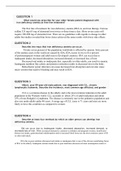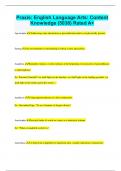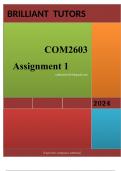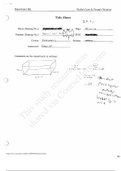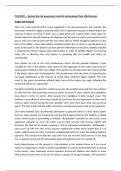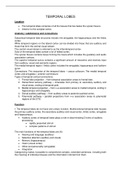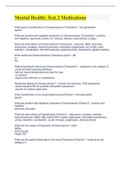Biology Nikhil 12Y Topic 2 Full Notes
TOPIC 2 – Genes & Health
Gas Exchange:
Diffusion: The net movement of particles from an area of high to low
concentration.
Molecules do diffuse both ways, but the net movement will be to the
lower concentrated area.
It can be said that they move down a concentration gradient. This is
the path of high low concentration.
The process of diffusion is passive meaning no energy is required for it
to occur.
Surfaces where gas exchange occur are adapted for their role, to increase the
rate of diffusion:
A large surface area:volume ratio. Larger objects have less surface
area:volume ratio than smaller objects.
Short diffusion distances.
Steep concentration gradient. In order for diffusion to be optimal, the
concentration of the 2 sides needs to be steep.
The human lungs are adapted for this. Gas exchange occurs between the
alveolar epithelium. Oxygen diffuses out of the alveolar epithelium and
through the capillary endothelium, into the blood where it binds to
haemoglobin. CO2 diffuses out and is exhaled.
There are many alveoli, increasing the surface area for gas to diffuse
across.
The alveoli and capillaries are only 1-cell thick, meaning diffusion
distances are short.
There is a sufficient blood supply, meaning that a steep concentration
gradient is maintained.
Fick’s Law states that the rate of diffusion is proportional (equal to), (the
surface area x the difference in concentration) ÷ thickness of surface.
Cell Membranes:
Cell membranes have a fluid mosaic structure. They are composed of
phospholipids, proteins, and carbohydrates (which are usually attached to the
proteins or lipids).
The model shows that the phospholipid molecules form a continuous bilayer,
which is fluid as the phospholipids are constantly moving.
, Biology Nikhil 12Y Topic 2 Full Notes
Membranes are partially permeable meaning small molecules can move
through gaps between phospholipids, but larger molecules and ions must
pass through channel proteins and carrier proteins.
Phospholipids are unique fats with a phosphate group head.
The head contains a phosphate group, which is hydrophilic meaning
it is attracted to water around a
cell.
The tail is made of 2 fatty acids
and is hydrophobic meaning it
repels water molecules.
These properties mean the
phospholipid molecules arrange
themselves in a bilayer, with the
heads facing out towards any
water, and the tails facing inwards,
making the centre of a cell membrane hydrophobic. As a result, the
membrane doesn’t allow for soluble substances to diffuse through it.
Some phospholipids have a polysaccharide carbohydrate chain
attached to them. These are called glycolipids.
Protein molecules are scattered throughout the bilayer.
They can move around the
bilayer, as the phospholipids are
constantly moving.
Some proteins in the bilayer can
have a polysaccharide
carbohydrate chain attached to
them. These proteins are called
glycoproteins.
Channel and carrier proteins are embedded in the bilayer.
Cholesterol is also present in the cell membrane and sits between
phospholipids, and the bonds that they form with the phospholipids can make
the membrane more rigid.
Transport Across the Cell Membrane:
Facilitated Diffusion uses carrier and channel proteins mentioned above. It
is a passive process, meaning no additional energy is required.
There is a need for this process, as larger molecules such as amino
acids and glucose, and charged particles such as ions, can’t diffuse
through the bilayer.
Particles still move down a concentration gradient, but do so with the
aid of proteins in the bilayer.






